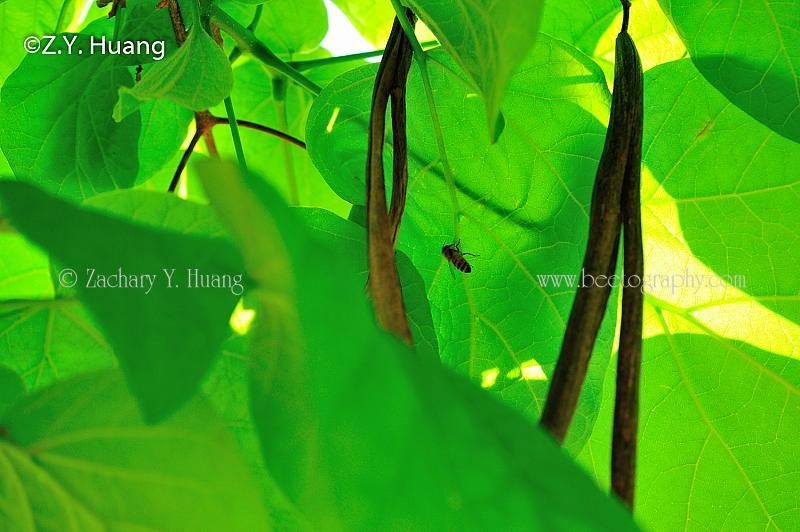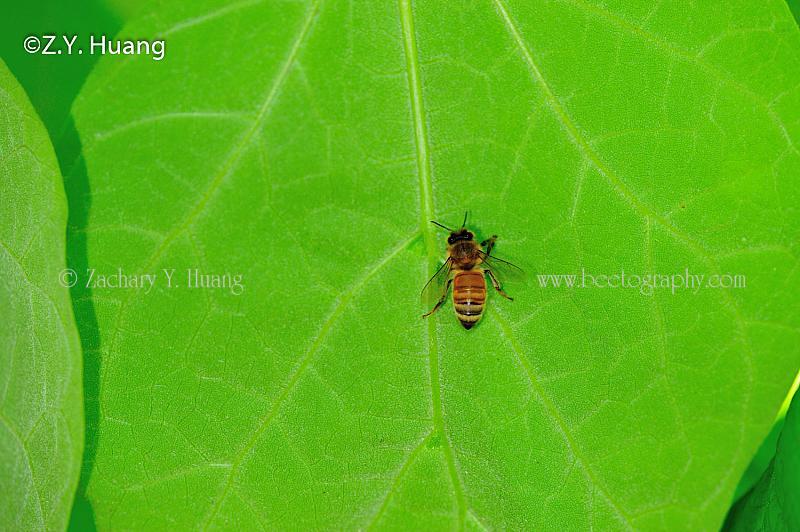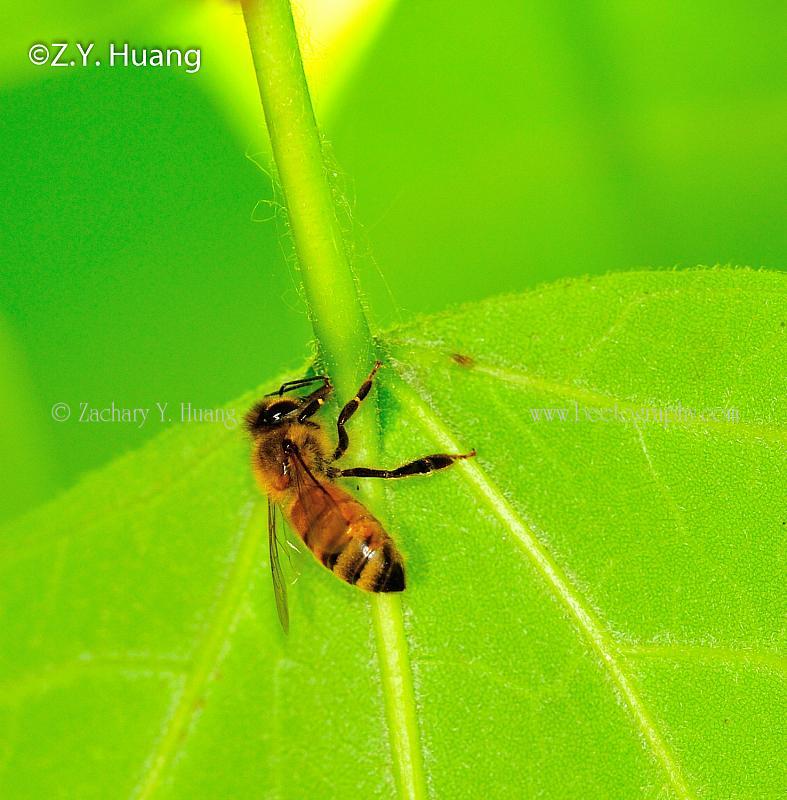There was on post (June 23rd, 2016), I was begging everyone to show me if they saw honey bees foraging on catalpa leaves. No one responded.
On Sunday June 26, I finally had the luck to see honey bees foraging on the back of catalpa leaves. I was going to give up after waiting for 10 min on the blooming tree, but decided to walk to the other tree (finished bloom about one week ago). Then I saw one honey bee foraging! I started shooting the bee (with my camera, of course) and another bee showed up. I went back to the blooming tree (30 ft away) and saw another 2 bees. So there were at least 4-5 honey bees foraging on the catalpa leaves, from 9:15-10 am Sunday morning…
Now, I finally have photos to prove this! (after visiting 6 trees and at least 10 trips!). Will try to keep an eye how long honey bees will forage on the plant. My friend in Canada said he saw more honey bees in July. One paper described nectar production by the leaves and said production peaked in July in Georgia. Apparently trees benefit by attracting ants to the leaves, who in turn would protect the trees from caterpillars (the catalpa worms are good fishing bait, I was told, but I have not seen them yet).
I googled for “catalpa leaf honey bees” and it came up with one single image with 2 bees on a leaf, but both were on the upper side of the leaf, so I do not think they were foraging on the tree. I did not observe bees go to the upper side at all when they were foraging for nectar. So, enjoy the first few photos of honey bees foraging on catalpa leaves!
- A honey bee foraging on the underside of a catalpa leave (Catalpa speciosa, Bignoniaceae). I can see about 6 extrafloral nectaries on this leaf. The bee is on the 5th one, counting form the top. The nectar would lighten up the leave.

2. But it can be tricky to count. For the above one I only counted one per main branch (except the basal one, there are always 2). But you can see where the glands are by their slightly different color here, the bee is stepping on one (under the left wing), so there also two here. The one at the lower location only had one on the left.

3. A honey bee licking nectar off the extrafloral nectary on the left side. You can see a wet spot on the right side also.

Other plants with extrafloral nectaries: cotton, cherry (all cherries have 2 glands at the base of each leave, this is how I differentiate a cherry tree from a peach or plum), Roselle (Hibiscus sabdariffa) (I have photos of bees foraging on them).


We have numerous catalpa trees at our house. We also our beekeepers. In the summer the catalpa trees are roaring from the bees working the bottom of the leaves on the extra floral nectarines. (: it is amazing.
Maybe Jostaberry? I hit this page when I searched for a bee sucking on the underside of a leaf – I swear it looked just like a bee, but I couldn’t believe it.
I just saw honey bees all over the bottom of our catalpa tree,googled it to see what it was they were after ? Got here,figured I’d leave a comment. July 20 or so? North central ohio
I put in a Catalpa tree three weeks ago and it is loaded with bees. Will they harm the leaves?
I put another Catalpa tree in about six weeks ago and it has no bees at all. I wondered if one is a male species tree and one a female, if there is such a thing.
Do grapefruit trees have extra floral nectaries? Was searching to find out why there are beed foraging on the leaves of my two grapefruit trees even though they are not blooming right now, and I came across this post.
I am not aware that grape vines have extrafloral nectatries. Most likely aphids or plant hoppers who secrets honey dew.
I have video of them here in VA on my trees. I can share my observations if you would like.
What an amazing tree. Shhh nobody really knows about them yet!
I was out this AM June 24th to let my chickens out into their run and there were hundreds of honey bees on the bottom of the Catalpa tree. Looked again this evening and it looked like more. Amazing!
Hi,
I found many honeybees on the bottom of the Catalpa leaves in the garden and wondered why and read this page. Our Catalpa is not native (Belgium) and does not seem to have any other nectar foraging animals.
This is great news!
But I am wondering if bees forage on all Catalpas (Aurea? Purpurea?) or just Catalpa bignonioides?
We live in central east Illinois. Our catalpa tree is loaded with bees about 1 week after it bloomed. We can hear them from our porch there are so many. They are on the under side of the leaves. Bees, wasps and flies. This is the second year we have lived here so it is new to us. I have 4 hives of bees and am thrilled to see this.
Im in neastern middle tennessee. We have 2 large southern catalpas, planted for the worms. We have honey bees working the underside of the leaves. There is a loud hum all day from the bees. June, 18 2021. I thank you for the information, i was afraid they would do something to the fishing worms, and i want those catapillers!!!! Love my catalpas, we have 2 more rooted to plant. Thanks
bees will do no harm to the worms.
I have several of these trees on my property and just had to do a quick google search about honey bees. I keep bees and the underside of the two biggest trees here are so “abuzz” with activity that I thought there might be a swarm. Just visiting bees from the hives that are maybe 400 yards away. This is interesting. Maybe I will place my swarm catchers closer to these trees next time.
Micah above nailed it. My catalpas are roaring with nectar foraging honey bees. I did my masters research on the foraging activity of honey bees and have no doubt that that is what is going on.